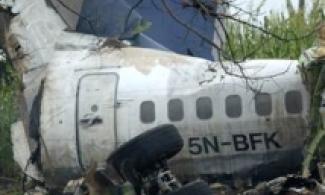
Loosely enforced safety regulations and spotty oversight were the probable cause of recent deadly jetliner crashes in Nigeria, a shocking new investigation by the Association Press news wire has found.
Loosely enforced safety regulations and spotty oversight were the probable cause of recent deadly jetliner crashes in Nigeria, a shocking new investigation by the Association Press news wire has found.
googletag.cmd.push(function() { googletag.display('content1'); });
Among the findings by Associated Press (AP) was that Abuja has still not released the formal records surrounding three fatal crashes in 2005-2006 including one in which a planeload of children going home for Christmas were killed.
In one of three incidents, a Bellview Airlines flight killed 177 people including a U.S. citizen, after it nose-dived into the ground at high speed, leaving human remains that were “nothing bigger than toes and fingers,” the report obtained by AP said.
The plane's captain, a 49-year-old former pilot, had been hired by Bellview after he had been working at a dairy for about 14 years, the summary read. The pilot also had been "shot in the head during a robbery attempt" during that break from flying, the report said.
Another incident — an Oct. 29, 2006 Aviation Development Co. flight from Abuja to Sokoto — killed 96 people, including the top spiritual leader for the nation's Muslims. The plane crashed 76 seconds after going airborne.
Just before the crash, alarms began sounding in the cockpit and the pilots' incorrect actions stalled the plane, according to the report.
"Although bad weather may have created the situation, which the pilots reacted to, they reacted inappropriately," the report reads.
Even more disturbing for investigators was the airline's operation manual for pilots and cockpit staff, which "did not contain any information on adverse weather condition as that section was blank."
The manual was duly approved by the Nigerian Civil Aviation Authority despite containing the blank section.
"The deficiency in the operation manual would probably make it difficult for pilots to take appropriate decision on when to go or not to go in (an) adverse weather condition," the report said.
Nigerian officials have offered conflicting reasons for the three major crashes in 2005-2006, never releasing full reports on what happened.
At the Bellview crash site, deep in rural Nigeria, villagers looted the few pieces of what remained from the plane, likely including its "black box" recorders, according to an investigation summary.
The Dec. 10, 2005 crash of a Sosoliso Airlines flight full of schoolchildren from Abuja to Port Harcourt, which killed 107 people, appears to have involved both pilot error and weather.
The pilot was "reportedly racing a thunderstorm" nearing the airport, an FAA memo reads. The inclement weather also forced the pilot to make an instrument landing — meaning that visibility had been reduced to the point the pilot needed to rely on instruments to make his landing, the report read.
The plane crash landed on the grass alongside the runway, broke apart and caught fire.A 2009 study done for the World Bank concluded the aviation authority spends more than 90 percent of its budget on salaries and cannot fund training or equipment needs.
googletag.cmd.push(function() { googletag.display('comments'); });
googletag.cmd.push(function() { googletag.display('content2'); });